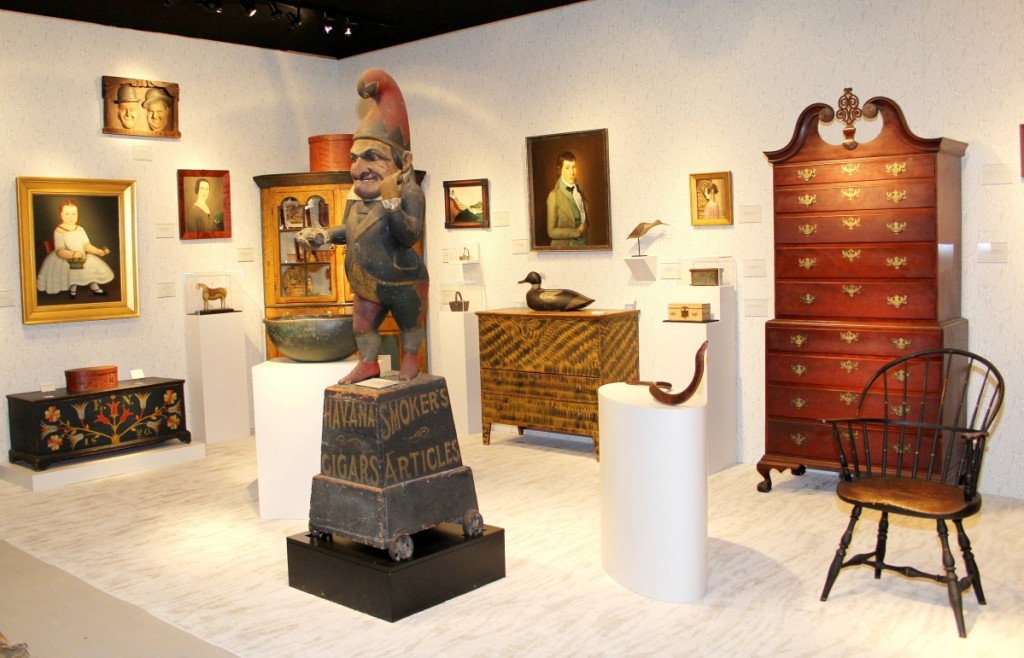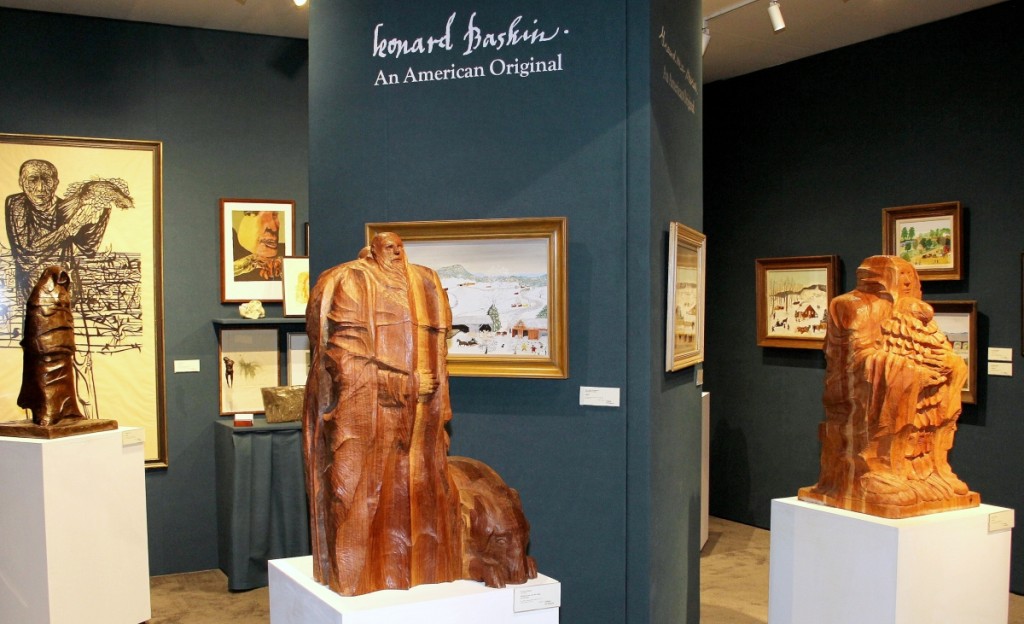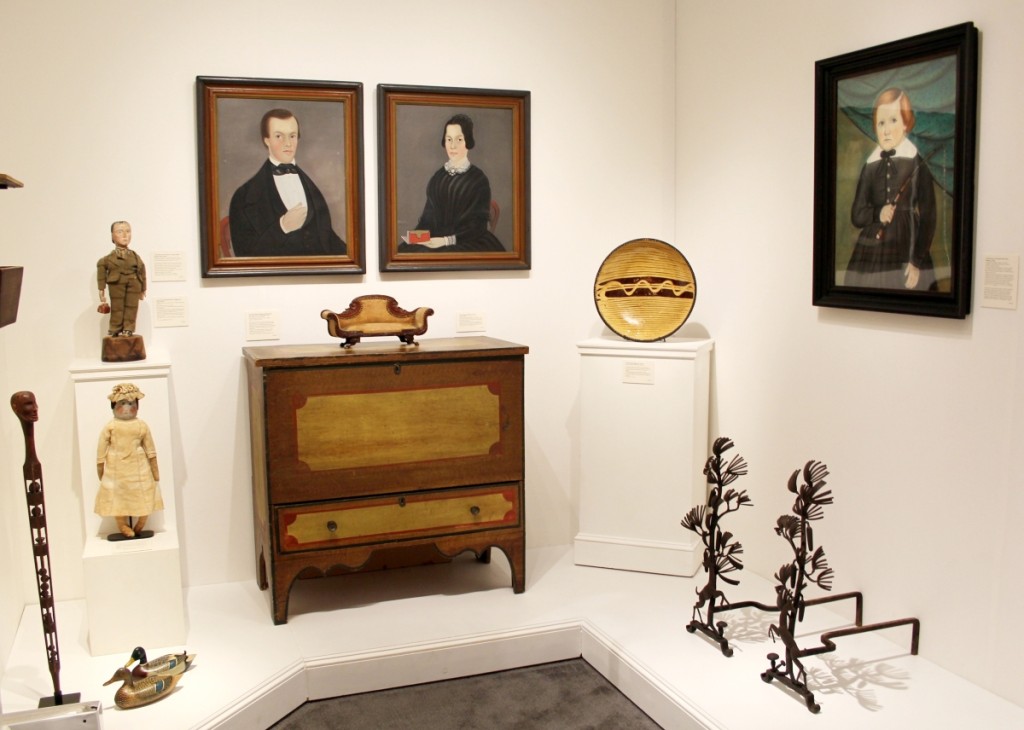Review and Photos by Laura Beach
NEW YORK CITY – Hours before the 63rd Winter Antiques Show was set to preview to a select group of revelers on Thursday evening, January 19, Michael Diaz-Griffith, the fair’s assistant director, was posting photographs to Instagram. “It’s what assistant directors do these days,” said Diaz-Griffith. As reported online by Scott Reyburn in The New York Times the following day, the art world is flocking to the social media outlet that favors sophisticated eye-candy and pithy prose over the quotidian intimacies of other platforms.
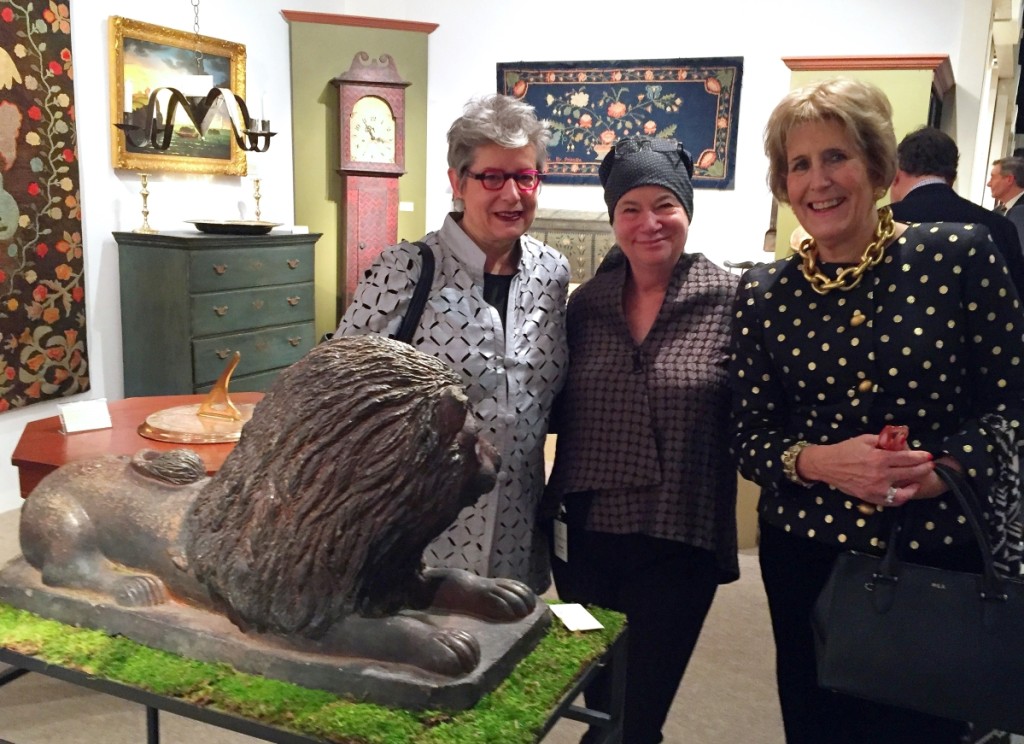
From left, Winterthur’s chief curator Linda Eaton, Grace Snyder and dealer and show manager Diana Bittel examine a glazed stoneware lion of circa 1830 at Elliott & Grace Snyder Antiques, South Egremont, Mass.
For Winter Antiques Show co-chairs Lucinda C. Ballard, Arie L. Kopelman and Michael R. Lynch and the fair’s executive director, Catherine Sweeney Singer, steering the legacy event, which continued at the Park Avenue Armory through January 29, is a delicate balancing act, one that requires upholding tradition while acknowledging the world is changing. That has meant making the show more diverse, infusing it with a youthful vitality, paring back some old-line specialties and, yes, promoting the show electronically, subtly and throughout the year, especially to younger audiences.
“Consistently this year, our exhibitors commented on the quality of visitors. They saw regular clients, but also new customers, which is what we count on,” said Sweeney Singer.
There was almost nothing ordinary about the 2017 show, which coincided with the inauguration of the nation’s 45th president, street protests on the opening and closing weekends, economic and political uncertainty, even warmer than usual weather. Perhaps most notable was the sense that the watershed moment had arrived when the upper stratum of the antiques industry recognizes that reaching new audiences depends not only on embracing new media, but using technology to relate antiques to broader cultural phenomena.
The trend was evident at Sotheby’s, which tapped into the success of the Broadway musical Hamilton to guide its sale of Hamilton-related letters and manuscripts to $2.1 million and its Americana Week receipts overall to $19.4 million, and at the Wunsch Americana Foundation, which has been using social media and gatherings in fashionable venues to encourage interest in decorative arts in younger audiences. The intent is to free historic art and design from what some see as an ossified context grown remote from everyday lives, especially those of the young.
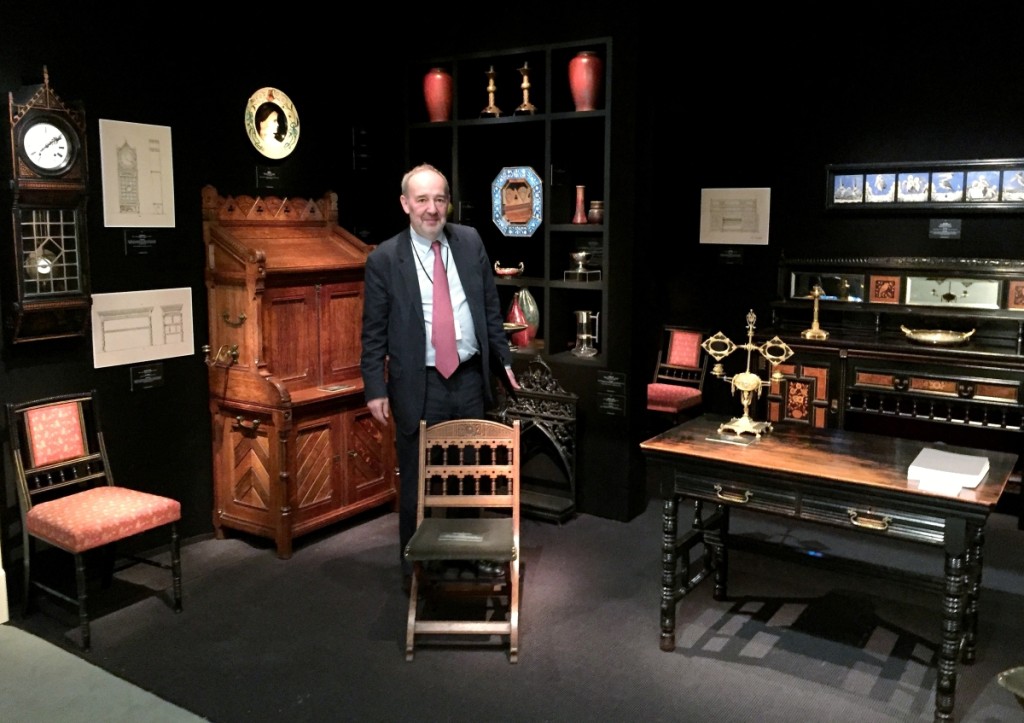
London dealer Martin Levy of H. Blairman & Sons, Ltd, mounted a thematic display of furniture by the architecturally trained designer Bruce Talbert.
Though it is no longer an Americana venue per se, the Winter Antiques Show is a clear expression of American taste. Carrying the banner for domestic style was this year’s loan exhibition, “Revolution & Evolution,” organized by the Abby Aldrich Rockefeller Folk Art Museum (AARFAM) at Colonial Williamsburg.
“We brought a cross-section of materials representing the American spirit from the Eighteenth to the Twentieth Century,” said Ronald L. Hurst, chief curator of the Colonial Williamsburg museums, of which AARFAM is a part. The exhibit celebrates the folk art museum’s 60th anniversary and is Colonial Williamsburg’s second appearance as the Winter Antiques Show’s loan presentation in less than two decades.
Greater diversity inevitably means less depth in individual specialties, a deficit the show’s Americana dealers overcame with outstanding presentations. New this year, Boston dealer Stephen Score brought the kind of portraiture, painted furniture and hooked rugs loved by his friend and mentor Nina Fletcher Little. In fact, some of his offerings had been owned by the exceptional collector of American folk art.
David Schorsch and Eileen Smiles bracketed a handsome chest-on-chest with penetrating portraits by William Jennys and Deacon Robert Peckham. The later sold, as did a charming watercolor portrait on paper of a young Virginia woman in a pink dress by Charles Burton.
Pennsylvania dealer Kelly Kinzle got off to a quick start with the sale of the 1843 portrait of a New York City fireman by Jefferson Gauntt (1805-1885). A rare Harvard, Mass., Shaker alphabet board and an unusual carved sandstone mantel from Ohio were other striking novelties.
Needlework authorities Stephen and Carol Huber sold their showpiece, a lavishly embroidered and richly symbolic blue apron honoring the Order of the Free Gardeners Society, an organization that originated in Seventeenth Century Scotland.
“I think it’s the most beautiful of them all,” Patrick Bell of Olde Hope Antiques said of “The Old Covered Bridge,” a painting Grandma Moses dated December 24, 1943. The primitive work hung under a carved Bellamy eagle plaque in the front of Olde Hope’s booth. Responsible for the artist’s meteoric rise, Galerie St Etienne sold five Moses paintings, plus carving by the emerging artist Leonard Baskin.
“Brown furniture is alive and well. The best examples of American furniture from the Neoclassical and Aesthetic periods are still of great interest to collectors,” said Hirschl & Adler’s Liz Feld.
Bernard & S. Dean Levy certainly agreed. New York dealer Frank Levy confirmed the sale of several of his most important pieces: the Bradlee-Fulton family Boston tea table with slides, circa 1750; a New York center table made by Duncan Phyfe that was featured by the Metropolitan Museum of Art in its 2012 retrospective on the cabinetmaker; a Phyfe worktable; a McIntire-carved card table from Salem, Mass.; a pair of Providence, R.I., Federal side chairs; and Queen Anne chairs. “Happy? I would say relieved,” Levy said modestly.
A delectable coastal Eighteenth Century New Hampshire armchair with a fan-carved crest and brush feet was an early sale at Nathan Liverant and Son, Connecticut dealers who also placed a Salem, Mass., highboy and a New London, Conn., chest of drawers. “It’s a great time to buy,” said principal Arthur Liverant, who also featured boxes for under $1,000 for less well-heeled collectors.
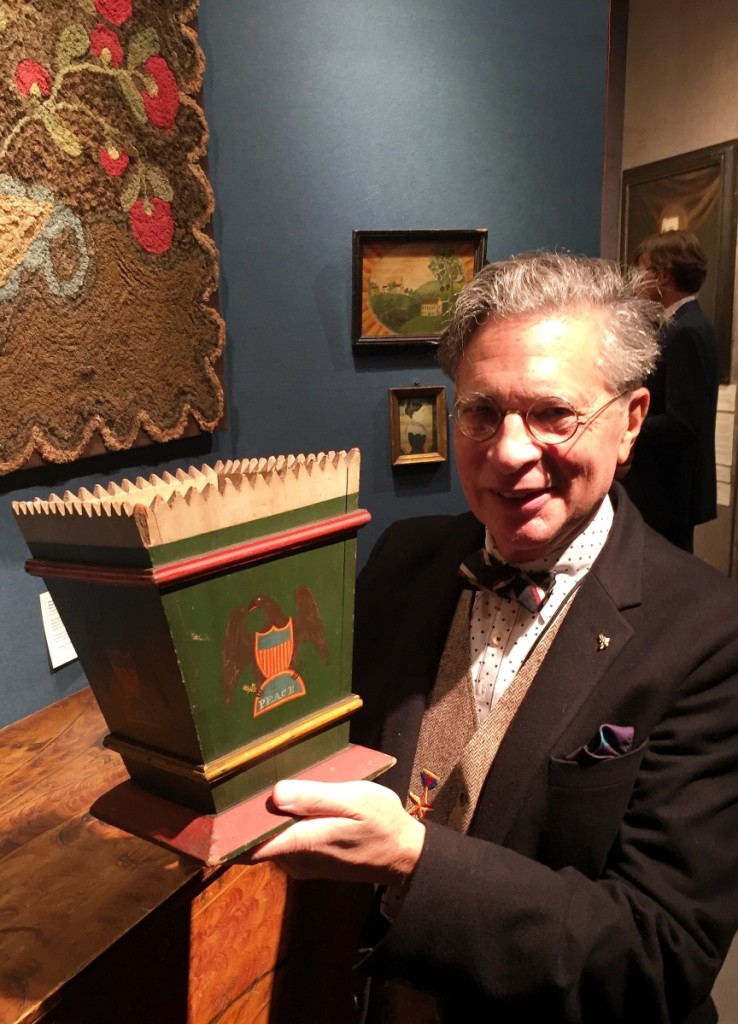
Stephen Score with a bucket decorated with eagles and shields and inscribed Peace, Hope, Love and Faith.
Compatriots in the fine arts area also did well. Michael Altman wrote up paintings by John Singer Sargent and Helen Frankenthaler. Tillou Gallery sold “Yawning Tiger,” a bronze by Anna Hyatt Huntington. Schwarz Gallery parted with “At The Window,” a 1914 canvas by Adolphe Borie.
Portraiture is as nuanced as the society it depicts, something the socially adroit Elle Shushan conveys in her inventive displays of miniatures in all mediums. Her stock ranged from irresistible folk art likenesses by Justus DaLee and Mrs Moses B. Russell to the tiny portraits of canines and humans by contemporary art photographer Bettina von Zwehl, who lives in London. One noteworthy sale was a wax portrait, for which related documentary evidence survives, of a beardless Abraham Lincoln.
“There was interest in almost everything we had. We sold seven major objects and a number of smaller items, from maps to Twentieth Century prints,” said Robert K. Newman of Manhattan’s Old Print Shop. Book dealer Daniel Crouch of London dispatched the first large-scale map to show the 13 American Colonies.
“It’s a prime example of the English Tudor Renaissance, thought to be a portrait of King John,” the English dealer Jonathan Coulborn said of a carved oak panel dating to about 1530. Thomas Coulborn & Sons sold a George I studded leather coffer, a pair of Charles II giltwood lions and a two-sided China Trade painting depicting the Whampoa anchorage and the hongs of Canton.
London antiquarian Ronald Phillips, Ltd, parted with a pair of George III mahogany pedestal tables attributed to Wright and Elwick. The dealers noted the survival of a drawing by Thomas Chippendale related to the pedestals’ design.
Better known for Americana, Elliott and Grace Snyder have expanded their inventory of choice, early English pottery, textiles and metal, a fruitful direction. The Massachusetts dealers sold an important brass sundial with a history of having been at Hampton Court Palace.
A popular source for English and European naive art, London dealer Robert Young Antiques made 56 sales, among them a French trade sign and a 1924 mannequin in swimming garb. The latter was apparently an advertisement for sporting gear.
In the category of Twentieth Century design, Macklowe Gallery sold a pair of Tiffany Studio sconces and Lost City Arts parted with a Nakashima desk.
Many exhibitors are essentially independent curators, providing essential expertise to museums looking to build and refine collections. Notably, H. Blairman and Sons, Ltd, of London, and Joan B. Mirviss of New York City mounted thematic, scholarly exhibits. Highlights of the Blairman display, devoted to furniture by the great Nineteenth Century British design reformer Bruce Talbert (1838-1881), included an inlaid Talbert sideboard, clock case and writing table. All dated from between about 1875 and 1881, and were accompanied by facsimiles of preparatory drawings. The Mirviss presentation, “Ao: Colors of Nature in Blue and Green,” showcased antique to contemporary Japanese art reflecting the deep national reverence for the palette, one thought by Japanese to represent earth and sky.
Sweeney Singer pronounced two collaborative booths – one organized by American paintings and sculpture specialist Jonathan Boos in partnership with photography expert Peter Fetterman, the other arranged by historic wallpaper authority Carolle Thibaut-Pomerantz with the David Gill Gallery, a London source for contemporary artist-designed furniture and accessories – a success. “We expect to have more collaborations going forward,” she said following the fair’s close.
As Instagram’s importance grows, one longtime exhibitor, A La Vieille Russie, may be benefiting from its expanding audience of more than 18,000 followers. As retold by gallery principal Peter L. Schaffer, a man and a woman walked into his booth and asked to see an emerald-cut diamond ring. The man asked the woman if she really loved the ring. She did. Next thing Schaffer knew, the man had dropped to one knee to issue his proposal of marriage. “It was a surprise to us and to her,” said Schaffer. It seems love, and the Winter Antiques Show, are eternal.
Benefiting East Side House Settlement, the 64th Winter Antiques Show is planned for January 19-28, 2018. For information, www.winterantiquesshow.com or 212-987-0446.

